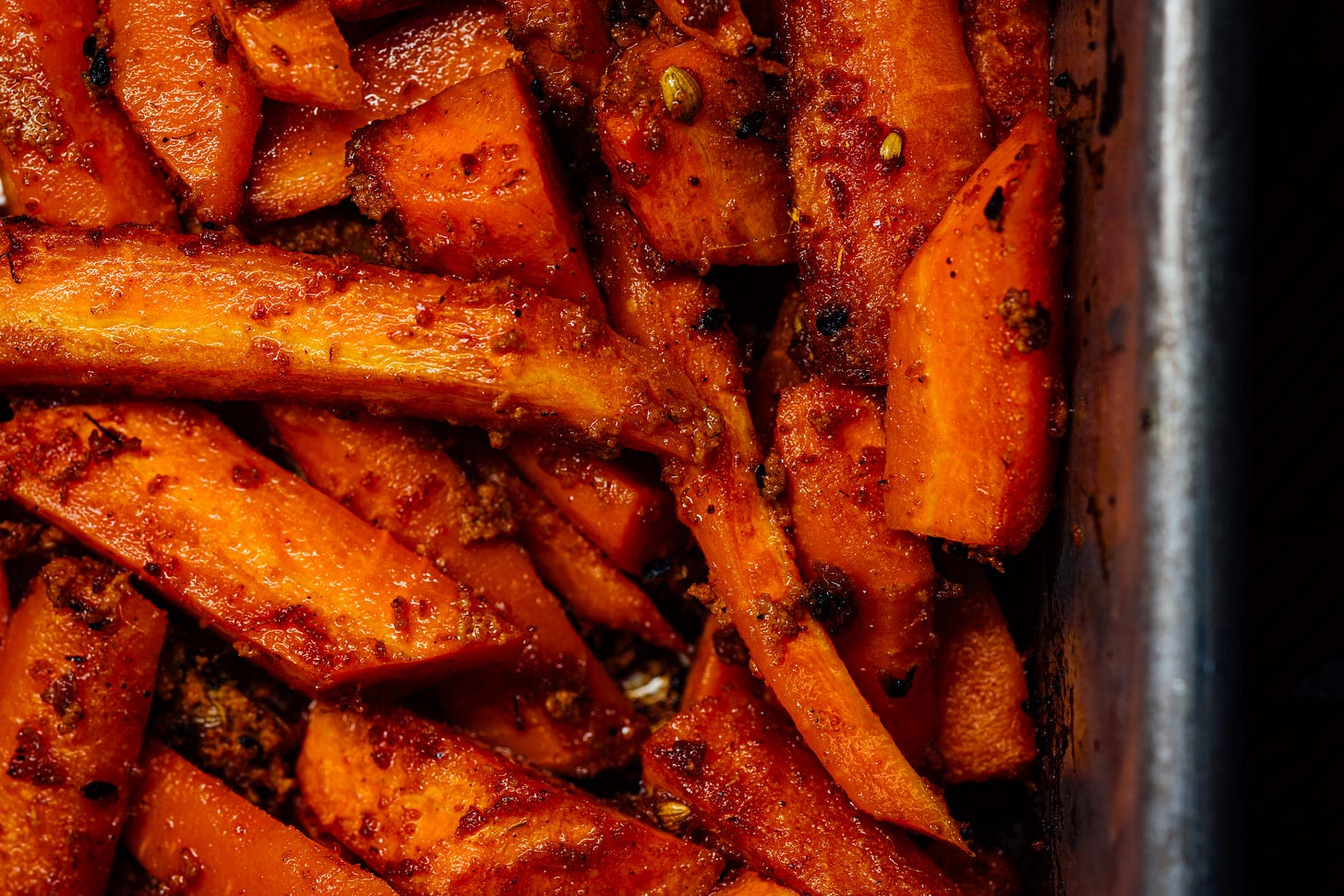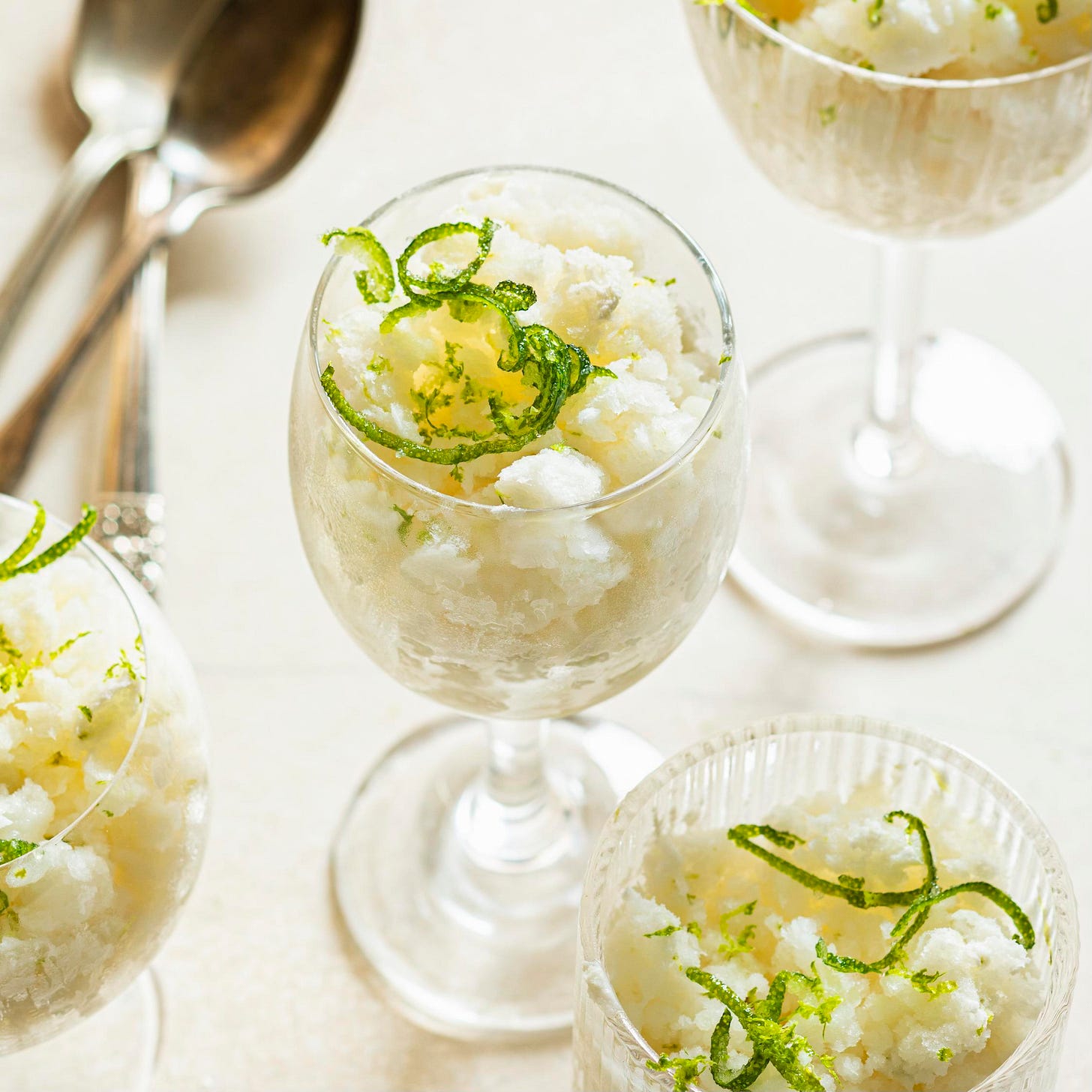🔥 From Fire to Ice: Tandoori Grilled Carrots + the Granita I Can’t Stop Scraping
Smoky, spiced carrots that hold their own on the grill—and a coconut-lychee granita that tastes like vacation. One hot, one cool, both absolutely worth it!
It’s peak grilling season—and peak produce season, and I can’t think of a better way to bring the two together than with tandoori vegetables. Smoky, spiced, deeply charred, and boldly flavored, tandoori-style cooking works surprisingly well with the right vegetables. But the trick? Choosing the ones with the structure to hold up to the heat.
If you’ve ever tried tossing delicate zucchini rounds or thinly sliced eggplant into a hot oven or onto the grill, only to watch them collapse into a mushy mess. In that case, you already know: not all vegetables are built for this kind of intensity. Tandoori cooking requires vegetables with sturdier textures—ones that can absorb a marinade, withstand high heat, and develop a smoky crust without falling apart.
That’s why I’m reaching for crunchy, firm carrots this summer.
Carrots (especially thick ones, halved or quartered lengthwise) are just the kind of vegetable that thrives in this environment. They grab the spiced yogurt mixture beautifully, caramelize in all the right places, and pick up that slightly charred, smoky flavor that makes tandoori cooking so irresistible.
Why Sturdier Vegetables Work Better:
Tandoori-style cooking relies on a high-heat environment (traditionally a clay tandoor, but at home, we use the oven, grill, or even a cast-iron pan). At these temperatures, water evaporates quickly. Vegetables with low water content and higher structural integrity, like carrots, cabbages, beets, sweet potatoes, celeriac, and even cauliflower, don’t collapse or weep as easily. They develop a seared exterior while the insides cook to tender perfection.
Science Corner:
The proteins in yogurt help with browning, thanks to the Maillard reaction. Acids from lemon juice or vinegar will help brighten the flavors. And when you pair that with sturdy produce, the result is a vegetable with flavor that’s both deep and bright—smoky, tangy, and kissed with spice.
In this week’s post, I’m sharing my recipe for Tandoori-Roasted Carrots —a dish that’s as good hot off the grill as it is at room temperature. It’s simple, vibrant, and makes a strong case for why vegetables deserve a spot in your upcoming cookout lineup. Use this tandoori spice mixture to experiment with other vegetables too.
Why I Avoid Calling this Tandoori Spice Blend a Marinade
We often assume that marinades will "tenderize" vegetables in the same way they can with meat. This likely comes from a surface-level association: "marinate = make soft + flavorful." But the science behind how marinades interact with meat and vegetables is fundamentally different.
The Science: Meat vs. Vegetables
Meat
Meat is mainly composed of protein fibers (like collagen and myosin), which are tough when raw.
Marinades that contain acids (such as lemon juice or vinegar), enzymes (like bromelain in pineapple), or salt can denature proteins and break down connective tissue, thereby helping to tenderize meat.
Time matters: the longer the marination (within limits), the more opportunity for these effects to take place.
Vegetables
Vegetables are primarily made of cellulose, hemicellulose, and pectin—structural carbohydrates that don't respond to acid or salt in the same way proteins do.
Acids do not break down vegetable fibers the same way they do meat proteins.
Acidic marinades can sometimes firm up vegetables (think of how pickling crisps cucumbers).
Additionally, many vegetables have a high water content and absorb flavors more rapidly than meat, so prolonged marination isn't necessary.
Why This Matters in Cooking
Vegetables don’t need to be tenderized by a marinade. What they do need is surface flavor and sometimes a brief soak to allow salt, acid, or aromatics to cling or slightly permeate.
Over-marinating some vegetables (like zucchini or mushrooms) can lead to sogginess, off-textures, or overpowered flavors.
When and Why to Marinate Vegetables
Short marination (15 to 30 minutes) can add flavor without compromising texture.
Use marinades more for seasoning and caramelization (especially before grilling or roasting), rather than for tenderizing.
Vegetables like carrots, sweet potatoes, and cauliflower—those with denser cell structures —can benefit from longer marination, but not for tenderness. It's more about flavor absorption and surface browning.
Happy Grilling,
Nik
Coconut-Lychee Granita: The Summer Dessert I Can’t Stop Making (and Scraping)
We’ve had our moment with hot and spicy—now let’s cool off with something icy, floral, and ridiculously easy.
This Coconut-Lychee Granita is the chilled sweet treat I recently made at America’s Test Kitchen, and it’s giving you a tropical vacation in a bowl (or directly out of the freezer, no shame).
I love a frozen dessert that doesn’t require an ice cream maker, candy thermometer, or seven bowls in the sink. This Coconut-Lychee Granita is just that—and frankly, it’s the dessert I wish I had every time I’ve opened the freezer in July and found nothing but a tragic half-bag of peas.
This one’s got tropical flavor turned up to eleven: I toast the coconut to unlock its nutty, almost buttery aroma, then steep it in coconut milk so it infuses every bite with richness. Lychees bring that floral, perfume-y sweetness that feels nearly too luxurious to be this easy. A splash of lime juice adds a bright, punchy note, rather than a sugary sweetness.
And the texture? This is where the science gets fun. Sugar doesn’t just sweeten; it helps manage ice crystal formation. That means delicate flakes you can scrape with a fork and spoon straight into your mouth (or your guests’ if you’re sharing, but no judgment if you aren’t).
You can make this ahead, forget about it, and then casually serve it after a grilled dinner, as if you’re the kind of person who always has a granita on hand. Which, honestly, you might become.
Recipe’s below—go make it, freeze it, and thank yourself in a few hours.
Note: This recipe resides on ATK and is free. I love seeing you share your excitement! ATK makes several recipes from the residency available for free. You may need to enter your email address so they can send you more great content, but you can always opt out at any time. I’ve been a longtime subscriber to their newsletters and have found them super valuable. I hope that helps clarify how to access these co-created recipes—we put a lot of love into them, and I’d love for you to give them a try! I appreciate your support!





